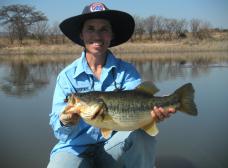Fishing techniques: Slow swimming a jig
It seems this year that we are not going to have a long-extended winter so I would like to start sharing a couple of sure-fire spring bass fishing techniques with you.
During the early spring, when the water is still cold but daylight hours and outside temperatures are increasing, bass will start moving toward the warmer shallows. They will still be cold and sluggish and not in the mood to chase down a fast-moving crankbait or spinnerbait. This is the time to start thinking of slow-swimming a jig!
Jigs are most often used in a pitching situation, in heavy cover, to mimic a crab or any other slow moving aquatic morsel. However, when tipped with a trailer with a bit of tail action, a swimming jig represents a slow-moving baitfish very well.
Colours – I am a fan of natural colours so, depending on the colour of the water, will select a jig in either brown, black and brown, watermelonseed, green pumpkin, pumpkin, or a combination of any of the above. These colours represent the colours of tilapia, our most dominant source of food for bass, very well. I will choose jigs in a natural white, silver or black combination to mimic the various gieliemienkies and river sardines found in our local waters.
When choosing a trailer for a swimming jig I will choose something like a Zoom swimming chunk, Yum Craw Papi, or Woolly Bullee and mix-and-match the colours; brown jig with green pumpkin or watermelonseed trailer, Silver/white jig with black trailer, etc. Study pictures of your baitfish and try to mimic their colours.
Technique – Make a long cast toward the bank, or where the bottom transitions from sand to rock, mud to gravel, gravel to scattered wood, etc. Allow the jig to settle to the bottom. With the rod tip held in the direction of the jig, start with a quick reel to lift the bait off the bottom and continue with a slow steady retrieve back towards you. Vary the speed of the retrieve; a slight pause will allow the jig to flutter down and pick up again as soon as the retrieve continues. You want to mimic the action of a baitfish moving in the water.
The secret is to keep the jig close to the bottom contour without dragging it in the mud. You want to feel the lure making contact with objects on the bottom now and then. When you do, give a slight pause and then pop the jig over or through the obstacle. If you feel your jig dragging on the bottom just speed up your retrieve slightly. If you haven’t felt the jig on the bottom for a while, slow down your retrieve until you feel it popping off the bottom again.
Set-The-Hook – Coldwater bites are often subtle. Pay attention to what your lure is doing and what it feels like as you retrieve. If you feel a tick or any suspicious weight at the end of the line...set the hook!














0 Comments